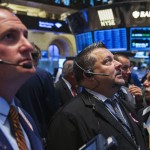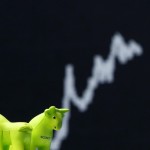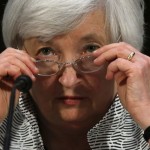Here's what it will take to trigger the next stock market correction …

As Wall Street hit another new record Thursday, it is worth considering what could cause a serious setback in stock market prices around the world. Since I started writing this column in 2012, I have repeatedly argued that the rebound in stock market prices from their nadir in the 2008-09 global financial crisis was turning into a structural bull market that could continue into the next decade.
Asset prices, however, never move in a straight line. It has been more than two years without even a 10 percent correction and five years without a 20 percent setback. This cannot go on.
Sometime in the not-too-distant future, investors are certain to suffer some big and painful losses — even if I am right in expecting equity prices to continue rising in the long term. What kind of event is most likely to end this bull run, or at least interrupt it with a setback of 20 percent or more?
The obvious answer is a major economic crisis, such as the near-breakup of the eurozone in 2011-12 or a U.S. recession. Another possible trigger would be a substantial increase in interest rates.
All the worst bear markets in living memory — 1973-74, 1980-82, 2000-02 and 2007-09 — occurred after a series of rate hikes by the Federal Reserve, and monetary tightening is the most widely discussed investment risk today. But on closer inspection, neither economic fundamentals nor monetary policy looks like a serious threat, at least in the year ahead.
Almost all recent evidence from the U.S. economy suggests acceleration rather than slowdown. Though a renewed recession in Europe or Japan is more likely, this would not cause much financial shock, since neither of these economies has yet fully emerged from the slump of 2009.
An increase in interest rates big enough to trigger a stock market correction appears even less likely in the next 12 months. This is because stock markets tend not to react adversely to the start of a monetary tightening cycle, which generally signals an improving economic outlook. History suggests that it takes a long series of rate hikes, spread over several years, to trigger a bear market.
But if no major economic crisis or substantial monetary tightening is on the horizon in the next year or so, we must conclude either that equity prices will keep rising without interruption or that the next bear market will be caused by something other than monetary policy or economic fundamentals. The most likely culprit in that case would be the internal dynamics of the market itself: extreme and unsustainable valuations as growing investor confidence turns into over-optimism and complacency.
Many commentators claim that stock markets have already reached this dangerously speculative condition. But this seems implausible, for two reasons. First, because standard valuation metrics are only just above their average levels in the United States and lower than average in most other markets — a point made repeatedly by Federal Reserve Chairwoman Janet Yellen and explained in my recent article on valuations.
Second, because the market’s behavior itself confirms that today’s valuations are not unreasonably elevated. If valuations were genuinely over-extended, investors would have sold equities far more aggressively in response to such pressures as the Fed’s tapering of bond purchases, the stalling of U.S. growth last winter, the disappointment (yet again) with European economic prospects or the conflicts in Iraq and Ukraine.
Investors have instead responded to the temporary setbacks caused by the disruptions by buying more equities at what they view as cheap prices — implying that valuations have not yet reached a dangerous extreme.
Which brings us to the bad news. If stock market valuations are not yet high enough to cause a big correction — and if monetary and economic conditions are likely to remain benign for the next year or two — then the unavoidable conclusion is that equity prices will just keep rising until they really do become over-extended. At that point, negative news events of the kind that investors can shrug off today as almost irrelevant will prove sufficient to trigger a serious correction.
What level of valuations will be high enough to make the market vulnerable? This question is virtually impossible to answer. But we can be fairly certain that when the market does reach this critical level, nobody will be aware of it — including me.
In this respect, the current investment environment is reminiscent not of the bull-market peak in 2007 that is often cited but of 1987 — the biggest of all stock market crashes but also the shortest and ultimately the least significant.
One intriguing resemblance is that 1987 came five years after the start of a bull market that was universally distrusted, like the current one. Even after four years of uninterrupted gains that started in August 1982, almost nobody believed that equities were a safe investment. Because it seemed ridiculous to suggest that the great inflation that had inflicted such terrible losses on investors in the previous decade was genuinely defeated.
By early 1987, however, skeptical investors began to thrown in the towel. Even those who did not understand or believe in the market’s advance decided to buy anyway. As a result, prices suddenly accelerated. The main Wall Street indexes gained 40 percent in the eight months from January to August 1987. The rest is history — in fact the biggest stock market crash in history. On Oct. 19, 1987, Wall Street gave up its entire eight-month gain in one day.
Could the current market cycle be headed for something similar? So far, there have been no signs of the acceleration in prices that preceded the crash of 1987. But if in the next few weeks the Wall Street records set in July are decisively broken, an acceleration could soon begin — especially if Yellen offers more reassurance on monetary policy and fears of a war between Ukraine and Russia subside.
Then investors should fasten their seat belts for a roller-coaster ride which, far from approaching its climax, may be just starting, with big gains ahead. And also big losses.
PHOTO (TOP): Traders work on the floor of the New York Stock Exchange shortly after the market’s opening in New York, July 28, 2014. REUTERS/Lucas Jackson
PHOTO (INSERT 1): Bull figures are pictured in front of the German share price index DAX board at the German stock exchange in Frankfurt, May 7, 2013. REUTERS/Lisi Niesner
PHOTO (INSERT 2): Federal Reserve Chair Janet Yellen adjusts her glasses as she testifies before the Senate Banking Committee on Capitol Hill in Washington, July 15, 2014. REUTERS/Kevin Lamarque
Link to original –
Here's what it will take to trigger the next stock market correction …
See which stocks are being affected by Social Media



